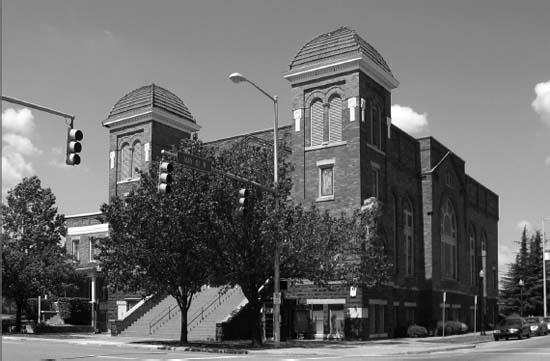ReligionThe Black Church in the Modern Civil Rights Movement |
What is the significance of Birmingham’s Sixteenth Street Baptist Church in the Civil Rights Movement? |
The Sixteenth Street Baptist Church in Birmingham, Alabama, had served as the primary meeting place for the community and as an important part of the planning and events of the civil rights activities in the 1960s. The bombing of the church in 1963, which killed four little black girls, was the most tragic of the period. The Sixteenth Street Baptist Church was first constructed as the First Colored Baptist Church of Birmingham, Alabama, in 1873. In 1911 a new building with three stories was constructed. It was designed by black architect Wallace Rayfield.
With the Supreme Court ruling in Brown v. Board of Education of Topeka, Kansas, in 1954, the South was charged to desegregate its public schools. Sixteenth Street Baptist Church served as the meeting place for marches and protests to impress upon Alabama the need to implement the ruling. The 1955 Montgomery Bus Boycott also pushed the state toward confronting many of its racist and separatists laws and attitudes. The resistance to change was prevalent from the lowest to the highest level of government in Alabama. When two black students—Charlayne Hunter and Hamilton Holmes—tried to register to attend the University of Alabama, Governor George Wallace attempted to deny their entrance by placing himself in front of the doors. Tension continued to mount, and in the spring of 1963 white supremacist groups took an even more aggressive response.
The community of Birmingham had been demonstrating for the end of segregation with the hope that the court-ordered integration of public schools would be implemented. On September 15, 1963, a Sunday morning, three members of the Ku Klux Klan planted nineteen sticks of dynamite outside the basement of the Sixteenth Street Baptist Church. Four young girls dressed in their “Sunday best” were in the basement, as they planned to attend the adult service, at 11:00 A.M. As the other children entered the basement after an earlier youth service the dynamite exploded; Addie Mae Collins, Carole Robertson, Cynthia Wesley, and Denise McNair were killed and twenty-two others injured.
This act of violence marked a new low that was condemned by blacks and some whites. This tragic event, along with the assassination of President John F. Kennedy two months later, helped the nation to realize the importance of equal rights and finally pass the Civil Rights Act of 1964, which protected blacks’ right to vote. The church was declared a national historic landmark on September 17, 1980.

During the 1960s, the Sixteenth Street Baptist Church in Birmingham, Alabama, was the hub of the Civil Rights Movement.
